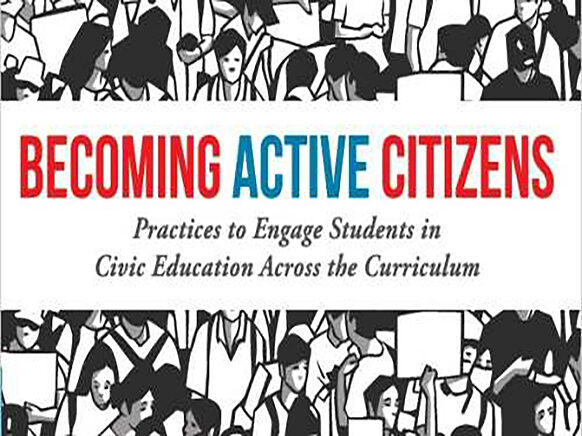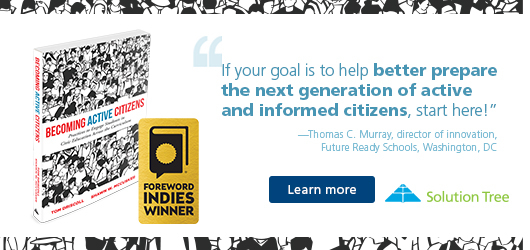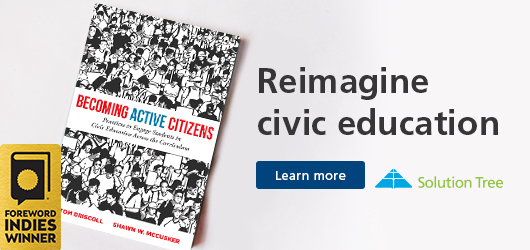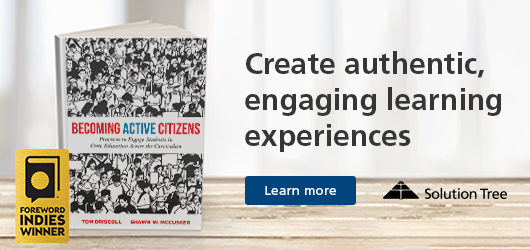This article originally featured on Foreword Reviews, and can be found at this link.
The very fine democracy we have inherited presents a challenge to every American citizen: can you keep it?
We owe it to our country—for the privileges we have been granted, the positive role the US plays around the world—to take this responsibility as seriously as possible. Therefore, we must all endeavor to learn the basics of democracy: the rights granted by the constitution, our system of checks and balances, the separation of powers, etc., and we must ensure that our children are raised with a fact-based understanding of their democratic rights and responsibilities.
As co-authors of Becoming Active Citizens: Practices to Engage Students in Civic Education Across the Curriculum, Shawn McCusker and Tom Driscoll accepted the challenge to keep America the beacon of democracy in a troubled world. We’re honored Shawn found the time to answer a few questions about the book, positive civic initiatives around the country, and whether he’s optimistic about America’s future.
Research suggests that most Americans don’t seem versed in the basic structure of government, the supreme importance of the separation of power, and the rights granted in the Constitution. So, there’s some work to do. As we’ll discuss later, there are many promising initiatives at play across the country to inspire and equip students and adults to become active citizens. Are you optimistic about what’s happening? If so, why?
Yes and no. Yes, because many states have taken steps to require a stand alone civic education course and allocated funds for materials and training for teachers. In those cases, the outcome is positive and very successful. No, because when bi-partisan legislation like the Civics Secures Democracy Act have become politicized, as state legislation in some states. Civics education reform need not be political and it is rarely successful when it becomes so.
You write that a “textbook understanding of democracy does little to teach [students] about perhaps the most important aspects of democratic society: how we resolve our differences peacefully and respectfully, as well as the consequences when we fail to do so.” And in chapter 4, Engagement in Civil Discourse, you point to a growing “elevator mentality,” whereby many people now shy away from conversations about politics. Please talk about the consequences, and why a reticence to engage in respectful debate is worrisome?
In fact, many Americans report that they no longer talk to a family member because of their political differences. But the long term effect of this that concerns me is that we risk losing the ability to discuss topics where we disagree. Schools need to allow students to share and listen to others opinions without making the discussion a competition that demands we declare a winner. In an elevator, behavior norms dictate that you do nothing, except stare at the numbers. Silence is the only socially acceptable behavior. That is what the norms for political discourse in America are becoming. We can only address problems that we are willing to face. If we never address these issues, they will smolder and continue to divide us.
Has technology and social media been an impediment or impetus for civic activism?
Powerful technology is neither good nor bad, but how we use it can be either. Part of the reason that we teach technology and digital citizenship is to model prosocial behaviors and explain the risks that occur when we don’t. The ability of technology to keep us informed is incredible. We can have direct contact with our democratic leaders, organize citizens to petition the government, and communicate with like-minded people all over the world. Those are powerful abilities.
But the age of information has now run headlong into the age of misinformation, making it necessary to work hard to make sure that we have accurate information. The ease of learning on social media has run headlong into the responsibility to weigh and vet everything we see and hear. While it may be easy for people to organize using social media, it is just as easy to organize a counter movement. I believe technology and social media have given a voice to people who otherwise did not have one but we need to continually socialize for ethical and safe behavior.
You cite Beth Holland’s article “We Were Warned” as a compelling argument that the 2020 election debacle “shouldn’t be surprising since that is what is expected when ‘our education system has failed to prepare the majority of citizens for active participation in a democratic society.’” Can you flesh this out a bit? How might “the big steal,” January 6th, and so much more have been avoided with civic education?
Beginning in the early 2000s, civic education and social studies classes were de-emphasized and defunded as No Child Left Behind focused efforts on improving reading and STEM skills. The result was nearly 30 percent less instructional time in elementary, middle, and high school. Meanwhile, the number one form of civics instruction in the US remains lecture. We would never let a kid jump into a pool after teaching them to swim using only a powerpoint presentation, but that is exactly what we do with civics in the US. Civics classes in the US very rarely allow students to BE citizens.
The story behind the “Big Steal” hinges on a very nuanced understanding of the concepts of separation of powers, checks and balances, and other key constitutional principles. But evidence shows that most Americans do not have an in-depth understanding of those concepts. As a result, partisan sides explain those concepts in the media in ways that are favorable to their cause. In order to understand what happened on January 6th, people sought answers in the media, often from partisan sources. Students who learned about government through rote memorization of definitions, having never attended a government meeting, had little chance to make sense of the complexity. The government we lecture about bears little resemblance to the one we experience in the wild.
You talk about the traditional approach to civic education (lecture) and “action civics”—which, among other things, encourages students to seek ways in which democratic institutions can be improved, not just as entities to revere—as one of the key components of your book. Please make the case for action civics?
The purpose of government is to serve the needs of its citizens. The system only works if the citizenry can effectively communicate those needs to government leaders. Action civics focuses on teaching students to engage the gears of our democratic institutions first hand. Ideally students identify a need, work to become informed, and communicate that need to government officials and agencies. These efforts need not necessarily be successful, because the real goal is to have students interacting with government and elected officials to learn what it takes to navigate democratic institutions. Much like you shouldn’t teach swimming without letting the kids jump in the pool, we shouldn’t teach civics without actually interacting with the government. Students who actually do this are significantly more likely to resolve their problems through democratic means in the future.
All politics is local, we are frequently reminded, but that phrase does seem apropos if the mission is to spur civic participation in local, state, and even school government, so as to allow youngsters to learn how to influence the everyday issues of their lives. Through the course of the book, you refer to dozens of topics and subjects beyond simply voting that fall into the sphere of civic education, from vaccines and redistricting to climate change, mortality rates, mail-in ballots, Black Lives Matter, gun regulation, LGBTQ+ rights, and so much more. What is the secret to helping students discover their issues of importance and getting them to act?
The key is to allow students to identify and pursue topics that are important to them. They need not be global issues; in fact, there is some evidence that it is more effective to choose smaller local issues that matter to kids. It might be bike racks in a community or sidewalk ramps for local senior communities. One group did a year-long study of the cost of accidents at one particular street corner in order to convince the city that it would be far cheaper to install a stop sign than to continue to have emergency services respond to the frequent accidents at a corner. This has the added effect of teaching about the responsibilities of citizens as well as their rights. The real secret is to have students learn primarily from an experience and then teach them in context, rather than teaching government through lecture, devoid from the practical application of what they learn.
Does today’s generation of teens and young adults show more of an inclination to get involved with government and politics than prior generations?
Yes. Unequivocally yes. Today’s students have social media and stay aware. They make buying decisions acting upon their beliefs. They are also typically unhappy with government’s ability to address their concerns. In part, this is because of the demographic bubble in our society that gives outweighed power to the baby boom generation. In the past, however, their knowledge of how to interact with the government to create change was limited to petitions and protests. But when a student understands how government bodies make decisions, they are more likely to engage within the system to share their beliefs and affect change.
Recently, Florida, under Governor Ron DeSantis’s Stop W.O.K.E. Act, deleted “prohibited topics” like “social-emotional learning,” which is part of the action civics approach you advocate. What is social-emotional learning and why is it controversial? Is the Republican party generally more resistant than the Democratic party to new ideas in the way civics are taught? Why?
Social Emotional learning is the teaching of social and emotional skills necessary for students to be successful in life. It includes skills like identifying and understanding our emotions in order to better navigate stressful situations. The academic research is unequivocal, including social emotional skills in the curriculum leads to better mental health and improved achievement.
Push back against SEL initiatives came as ideas like Critical Race Theory and SEL were lumped together during the pandemic partly because the need for SEL grew exponentially as many students were isolated socially during the lockdown. One state superintendent recently promised to remove all SEL from their 2700 schools, but when asked what SEL was, he could not define it.
SEL topics like Restorative Justice become controversial because they seek to address behavior through understanding rather than through traditional discipline and punishment. The Republican platform is to return schools to more traditional practice, as evidenced by the school takeover in Houston, where the new Republican appointed superintendent who replaced the elected school board immediately announced plans to close the district’s libraries in order to convert them to behavior centers.
As far as whether one party is more or less against reforms, Republicans are more skeptical of any new initiative in public schools in general. For example one state banned school teachers from requiring or suggesting that students write their state or federal representatives as part of a school assignment. Often politicians on the right take the word “action” in action civics to mean “activist.” Which is not accurate. There are many rural and conservative communities who have action civics programs in their schools where students pursue support for agriculture programs, improved internet access, and 2nd Amendment rights. These are all examples of action civics.
Please talk about how the pervasive mistrust in mainstream media is affecting the strength of our democratic society?
Evidence shows that Americans who watch cable news are far more polarized in their beliefs compared to those who watch local news broadcasts. The narratives of cable news are so far apart (from local news), it’s hard to view both without a heavy dose of cognitive dissonance. Which means most people don’t do it. The resulting crisis is that we don’t have a common set of truths that we operate under which makes it very difficult to find common ground as a starting point. That’s we as a society—we have largely stopped talking to each other about controversial issues.
You support teaching students the skills to identify credible news and information. What resources are available for fact-checking, developing research skills, understanding bias, differentiating news from opinion, etc.—to help with that mission? Can you give us a sense of the number of organizations currently working to help students and young adults become more active, knowledgeable citizens, and perhaps mention a couple favorites of yours?
There are excellent news media literacy resources available to teachers for free. Our book goes into great depth on how to use them effectively. The News Literacy Project and Common Sense Media are must have resources for all subject area teachers. The Stanford History Group is another incredible resource. I also really like materials from “Facing History and Ourselves.” Many of these resources are hands-on and experiential. I think the best ones allow students to roll up their sleeves and dive into evaluating actual media, oftentimes by using games. There are countless organizations that offer materials, but beware. There are many partisan organizations that produce resources with their own slant. So do your work before you commit.
And conspiracy? Are there initiatives afoot to help students understand the tricky power of conspiracies?
That is tricky because people who buy into conspiracy theories are convinced of their validity. A recent study suggested that the best way to counter conspiracy theories is to teach skills and strategies that are not connected to the conspiracy itself. For example, rather than countering a political conspiracy, you teach students the methods that marketers use to influence you so they can identify those methods in their political discourse. Research also shows that combating conspiracy theories through prevention is significantly more effective than trying to unwind the truth of an existing conspiratorial fever dream. However, these efforts are not being implemented widely, mainly because of politicization.
Engagement through Digital Games and Competition, chapter 6, details several civic education games and simulations, as a way to increase engagement. Have these proven to be successful?
Games and simulations are one of the six proven practices for effective civics instruction. Simulations can teach processes and nuance about how the government works. Perhaps the best example is iCivics. Their games are entertaining and informative while helping kids to understand the importance of government institutions.
You advocate for teaching civic engagement in English Language Arts, as well as science and mathematics classes—which seems a stretch. Please explain your reasoning?
The single most important message that I’d like educators to take away from the book is the idea that citizenship education needs to be owned by every teacher, not just the government teacher or the social studies department. When NCLB wanted to improve STEM and language skills, teachers across all subject areas and departments had to emphasize those skills. Civics is the same. Science teachers, foods instructors, and PE teachers can all discuss how government policy impacts their field, and therefore affects the lives of every person. When a school sees citizenship education as belonging to every teacher, their programs are significantly more successful.
For example, standard weights and measures is a function of government. Copyright and plagiarism standards stem from laws about intellectual property. Food in the cafeteria is regulated by law. We can do a great service to our kids by elevating this information and making these connections explicitly. After all, media literacy doesn’t just apply to social studies. There is disinformation about science and nutrition. Often disinformation is created by creative math, which can be combated by teachers teaching students about statistical games that politicians play. You may think that including civics across the curriculum is a stretch, but I argue that if you don’t, you aren’t really committed to an effective civics program, and research backs up this claim.
Any last thoughts?
I’m just really proud of the conversations that this book has generated around effective civics. It can be easy to shy away from the topic because civics lives right next to politics. We have seen that you CAN discuss civic education reform without triggering the culture wars and the schools that have risked doing so are finding success as a result.
Please check out EdTechTeacher’s services page, we offer top of the line professional development and grant writing assistance for your civics programs.





